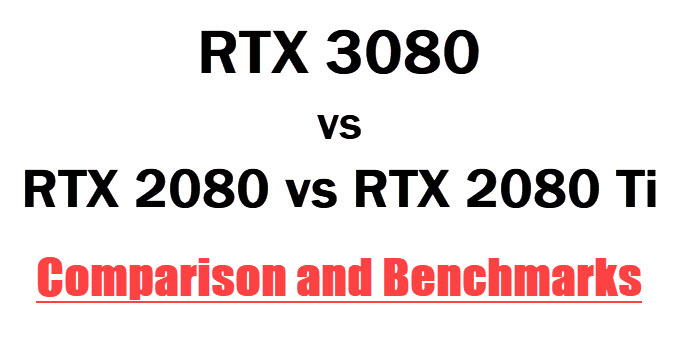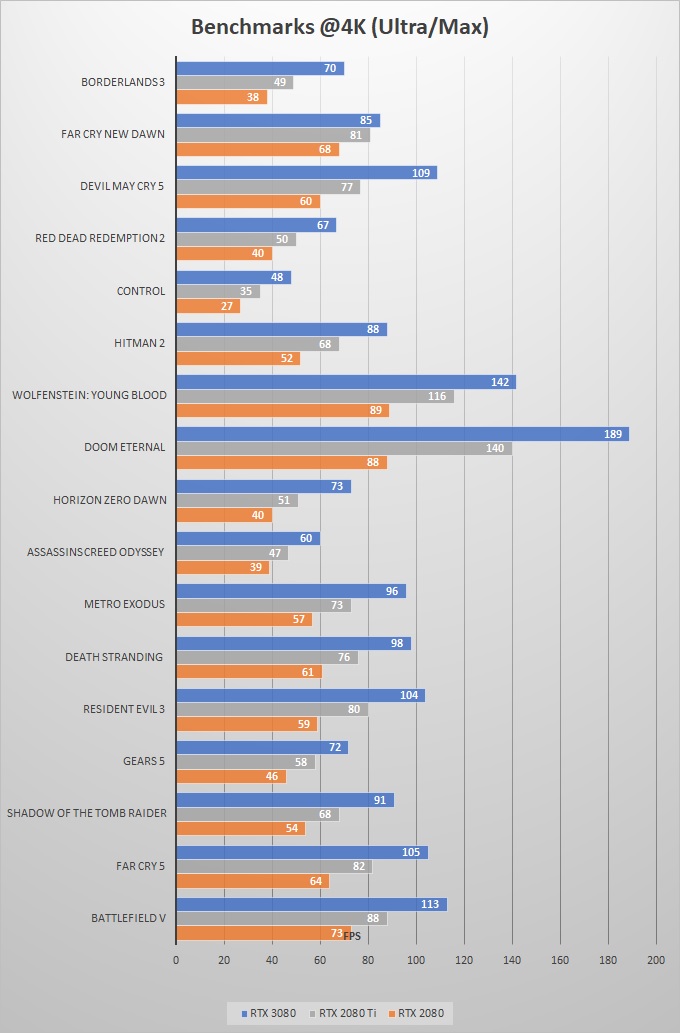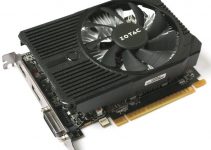GeForce RTX 3080 is the second most powerful graphics card in the new RTX 30 series from Nvidia. It is positioned below RTX 3090 and above RTX 3070 in the lineup. The RTX 30 series cards come with a new GPU architecture and have a smaller fabrication process. The RTX 3080 is a direct replacement for the RTX 2080 but it can even outperform the RTX 2080 Ti which is the most powerful graphics card in the older RTX 20 series and even in the world until the RTX 30 series came out.
 The RTX 3080 Founders Edition card also sports a different cooling solution with two fans operating in opposite directions; one as exhaust and the other one as a blower. RTX 3080 also comes with new features that can make a significant improvement in the gaming experience. So, to let you know how the RTX 3080 competes against the RTX 2080 and RTX 2080 Ti, here I am going to make a comparison between them based on important parameters.
The RTX 3080 Founders Edition card also sports a different cooling solution with two fans operating in opposite directions; one as exhaust and the other one as a blower. RTX 3080 also comes with new features that can make a significant improvement in the gaming experience. So, to let you know how the RTX 3080 competes against the RTX 2080 and RTX 2080 Ti, here I am going to make a comparison between them based on important parameters.
RTX 3080 vs RTX 2080 vs RTX 2080 Ti
Below is the comparison between RTX 3080, RTX 2080, and RTX 2080 Ti graphics cards based on their specifications, performance, pricing, power consumption, and features.
GPU Architecture
RTX 3080 is built on Nvidia’s latest Ampere GPU architecture on the 8nm process from Samsung. It comes with a whopping 8704 CUDA Cores, 68 RT Cores, and 272 Tensor Cores. On the other hand, RTX 2080 and RTX 2080 Ti are powered by Turing GPU architecture built on the TSMC 12nm fabrication process. The RTX 2080 Ti comes with 4352 CUDA Cores, 68 RT Cores, and 544 Tensor Cores while the RTX 2080 has got 2944 CUDA Cores, 46 RT Cores, and 368 Tensor Cores.
| RTX 2080 | RTX 2080 Ti | RTX 3080 | |
| GPU Chip | TU104 | TU102 | GA102 |
| GPU Architecture | Turing | Turing | Ampere |
| Fabrication Process | 12nm | 12nm | 8nm |
| CUDA Cores | 2944 | 4352 | 8704 |
| RT Cores | 46 | 68 | 68 |
| Tensor Cores | 368 | 544 | 272 |
Here you can observe that the CUDA Cores in RTX 3080 is double of what is present in RTX 2080 Ti and almost three times what is found in RTX 2080. The number of Tensor Cores present in the RTX 3080 is significantly lesser compared to RTX 2080 Ti and RTX 2080, but these are 3rd generation Tensor Cores that offer almost 2x performance increase over the 2nd generation Tensor cores found in RTX 20 series cards. Similarly, RTX 3080 has 2nd generation RT Cores that double the performance over RTX 20 series RT cores. The second-generation RT Cores also allow for concurrent Ray Tracing and shading operations and can now accelerate Ray Tracing with Motion Blur.
Video Memory [VRAM]
RTX 3080 comes with 10GB GDDR6X memory having a 320-bit interface. GDDR6X is currently the fastest graphics card memory that also delivers high bandwidth, comparable to what HBM2 memory can deliver. The GDDR6X memory on RTX 3080 runs at 19 Gbps and delivers a memory bandwidth of 760 GB/s, which is quite huge. On the other hand, RTX 2080 Ti and RTX 2080 come with GDDR6 memory that runs at 14 Gbps but has different bus widths of 352-bit and 256-bit. When it comes to memory size then also RTX 3080 has 2GB extra memory over RTX 2080 but 1GB less than RTX 2080 Ti.
| RTX 2080 | RTX 2080 Ti | RTX 3080 | |
| Memory Size | 8GB GDDR6 | 11GB GDDR6 | 10 GB GDDR6X |
| Memory Interface | 256-bit | 352-bit | 320-bit |
| Memory Speed | 14 Gbps | 14 Gbps | 19 Gbps |
| Memory Bandwidth | 448 GB/s | 616 GB/s | 760 GB/s |
Features
When it comes to features then also RTX 3080 is quite ahead of the RTX 2080 and RTX 2080. The RTX 3080 supports PCIe Gen 4 interface that offers double bandwidth over the PCIe 3.0. The card has now DLSS 2.0 (Deep Learning Super Sampling) which offers better image quality along with the performance. Also, the Real-Time Ray Tracing performance in the RTX 3080 is way better than that of its competitors. The other new features introduced with the RTX 30 series card include Nvidia Reflex (to reduce game latency ) and RTX IO which can reduce game loading time by using the graphics card video memory for game decompression of game data and textures. Another major addition to the RTX 3080 is the HDMI 2.1 support which can deliver much higher resolution and refresh rates on a single cable. HDMI 2.1 supports 8K@60Hz, 4K@120Hz, and up to 10K resolutions and it also includes the support for Dynamic HDR. The bandwidth supported by HDMI 2.1 is 48 Gbps, which is quite huge.
RTX 3080 does not support SLI or NVLink multi GPU interface while RTX 2080 and RTX 2080 Ti do by using the NVIDIA RTX NVLink Bridge. All these cards include the support for DirectX 12 Ultimate, OpenGL 4.6, Vulkan, and G-Sync. When it comes to productivity and streaming then RTX 3080 comes with 5th generation Nvidia Decoder and natively supports AV1, which is a royalty-free, highly efficient codec that can reduce the bandwidth by high stream resolution video by up to 50% compared to H.264, and can make 4K and 8K streaming feasible for someone with an average or mediocre internet connection.
| RTX 2080 | RTX 2080 Ti | RTX 3080 | |
| Bus Interface | PCI Express 3.0 | PCI Express 3.0 | PCI Express 4.0 |
| DirectX | 12 Ultimate | 12 Ultimate | 12 Ultimate |
| OpenGL | 4.6 | 4.6 | 4.6 |
| Vulkan | 1.2 | 1.2 | 1.2 |
| SLI | Yes – With NVIDIA RTX NVLink Bridge | Yes – With NVIDIA RTX NVLink Bridge | No |
| VR Ready | Yes | Yes | Yes |
| NVIDIA Encoder (NVENC) | Gen 7 | Gen 7 | Gen 7 |
| NVIDIA Decoder (NVDEC) | Gen 4 | Gen 4 | Gen 5 (with AV1 Decode Support) |
| G-Sync | Yes | Yes | Yes |
| HDMI 2.1 | No | No | Yes |
Gaming Performance
1440p & 4K Benchmarks
Here are the gaming benchmarks of these cards at 1440p and 4K resolution.


From the above benchmarks, you can see that the RTX 3080 is way ahead of RTX 2080 and also beats RTX 2080 Ti by a good margin. RTX 3080 card is around 60% to 70% faster than RTX 2080 at 4K and around 45% faster at 1440p resolution. When compared to RTX 2080 Ti, the RTX 3080 is around 30% faster at 4K and 20% faster at 1440p resolution on average.
Ray Tracing & DLSS Benchmarks

Here you can observe that RTX 3080 offers great performance in games with RTX and DLSS support, compared to RTX 2080 Ti and RTX 2080. You can see a significant increase in FPS when DLSS is enabled on RTX 3080 with or with or without Ray Tracing enabled.
Power Consumption
The rated power consumption figure for the RTX 3080 is 320W which is considerably higher than RTX 2080 and RTX 2080 Ti. However, RTX 3080 offers 1.9X Performance per Watt improvement which means it delivers much higher performance at less power and is quite a power-efficient card in that sense. The card requires a 750W power supply for its operation while the RTX 2080 and RTX 2080 Ti have a PSU requirement of 650W.
| RTX 2080 | RTX 2080 Ti | RTX 3080 | |
| Power Consumption | 215W | 250W | 320W |
| Recommended PSU | 650W | 650W | 750W |
Pricing & Availability
The Founders Edition of RTX 3080 and RTX 2080 retails at $699 while the base MSRP of RTX 2080 Ti is $999 at the time of launch. The production of RTX 2080 and RTX 2080 Ti GPUs have officially been stopped by Nvidia which means you won’t be seeing new stock of these cards in the future. RTX 3080 is a new product and its demand is very high in the market. It means they will go out of stock very quickly on the eCommerce stores. You can check the current prices and availability of these cards from the links given below.
Check RTX 2080 Price on Amazon
Check RTX 2080 Ti Price on Amazon
Check RTX 3080 Price on Amazon
| RTX 2080 | RTX 2080 Ti | RTX 3080 | |
| MSRP | $699 | $999 | $699 |
RTX 3080 vs RTX 2080 vs RTX 2080 Ti Specifications
| RTX 2080 | RTX 2080 Ti | RTX 3080 | |
| GPU Chip | TU104 | TU102 | GA102 |
| GPU Architecture | Turing | Turing | Ampere |
| Fabrication Process | 12nm | 12nm | 8nm |
| CUDA Cores | 2944 | 4352 | 8704 |
| RT Cores | 46 | 68 | 68 |
| Tensor Cores | 368 | 544 | 272 |
| Memory Size | 8GB GDDR6 | 11GB GDDR6 | 10GB GDDR6X |
| Memory Interface | 256-bit | 352-bit | 320-bit |
| Memory Speed | 14 Gbps | 14 Gbps | 19 Gbps |
| Memory Bandwidth | 448 GB/s | 616 GB/s | 760 GB/s |
| Bus Interface | PCI Express 3.0 | PCI Express 3.0 | PCI Express 4.0 |
| DirectX | 12 Ultimate | 12 Ultimate | 12 Ultimate |
| OpenGL | 4.6 | 4.6 | 4.6 |
| Vulkan | 1.2 | 1.2 | 1.2 |
| SLI | Yes – With NVIDIA RTX NVLink Bridge | Yes – With NVIDIA RTX NVLink Bridge | No |
| VR Ready | Yes | Yes | Yes |
| G-Sync | Yes | Yes | Yes |
| Power Consumption | 215W | 250W | 320W |
| Recommended PSU | 650W | 650W | 750W |
See also:
- RX 6800 XT vs RTX 3080 Comparison
- RTX 3090 vs TITAN RTX vs RTX 3080 Comparison
- RTX 3070 vs RTX 2080 Ti vs RTX 2070 SUPER Comparison
Final Thoughts
There is absolutely no doubt that RTX 2080 is a monster of a card and with such attractive pricing it becomes a very tempting and excellent product. The card decimates the RTX 2080 in every benchmark and even RTX 2080 Ti couldn’t able to come close to it in any benchmarks. RTX 3080 is certainly the card for high-end gaming but you should also have a processor that can fully utilize this card without being a bottleneck. This means to get the most out of this card you must have a high-end processor like Core-i9 9900K, Core i9 10900K, or Ryzen 9 3900X. Furthermore, this card is mainly meant for 1440p and 4K gaming which means you also need a high resolution and high refresh rate monitor to get the best out of this card. So, if you are looking to upgrade from a high-end GTX 10 series or entry-level RTX series card then the RTX 3080 is definitely a huge upgrade for you. Highly Recommended by me for serious gaming.
(*This post may contain affiliate links, which means I may receive a small commission if you choose to purchase through the links I provide (at no extra cost to you). Thank you for supporting the work I put into this site!)

![Best RTX 3050 8GB Models for 1080p Gaming [Custom AIB Models] Best RTX 3050 8GB Models for 1080p Gaming [Custom AIB Models]](https://graphicscardhub.com/wp-content/uploads/2022/01/ZOTAC-GAMING-GeForce-RTX-3050-Twin-Edge-211x150.jpg)
